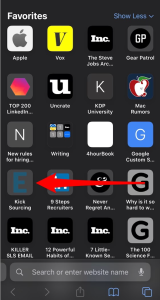There is one article from ERE that I keep front and center; I’ve kept on my iPhone favorites for more than a decade. It’s made my heart hurt for the longest time, and in the gritty arena of sourcing and recruiting, heartache is par for the course. This industry doesn’t just test your skills; it lays bare your soul.Evolution—from agency hustler to corporate negotiator—isn’t just about changing titles; it’s a crucible of character.

This fear has become my guiding light in this chaos, not a hindrance. It drives my ambition, not hindering it.
It makes me remember: every great recruiter has been shaped by the fires of adversity, not the comforts of complacency. Lean into the pain; it’s the forge of champions.
So what scares me so much?
It’s a ghost from the past that is haunting the future. As we talk about a Golden Age of Recruiting and its empowerment via AI, I stare at this article. In today’s hyper-connected age, everyone has visibility, but not everyone possesses the necessary skills. Simply because you can see talent doesn’t mean you can snag it. It’s like being at a crowded auction where everyone’s bidding on the same prize. This might speak to the decreased effectiveness of the beloved inMail, and (yes, if the inMail was not so beloved, we might not spray it with vitriol like we do).
The real differentiator?
It’s not just your wallet—it’s your wooing skills. And that is the point of this dead ghost. Sourcing is becoming simpler for the few, and more ubiquitous for the many.
The recruiting arena is turning gladiatorial, with firms vying for the same passive talent. The victors won’t just be those with the best algorithms, but those who can forge genuine connections, offer unparalleled value, and articulate a vision. In this talent gold rush, don’t just pan—be the magnet.
The game’s shifting; play smarter, not harder.
A Future That Did Not Arrive
According to Adler’s article, he proposed that by March 11, 2012, everyone would be connected by one degree of separation on LinkedIn or Facebook.
Surprise: March 11, 2012, came and went, and I still see 3rd degree connections aplenty on LinkedIn. Try it yourself. For me, it came to 1.9M 3rd connections who have “recruiter” in their profile. When I did as Adler suggests with 2nd connections, it shrunk to 196K recruiters that I am one step away from connecting. Hmmm… something fishy?
As much as Adler wants to “bring recruiting back to recruiting,” the data about his date is missing and mathematically amiss.
Let’s get something straight.
Hyperbolic projections, like the idea that by March 11, 2012, we’d all be connected by one degree of separation on LinkedIn or Facebook? Fantasy.
Sure, Big Tech would love us to believe their platforms have made the world that small. But conflating digital connections with genuine relationships is naive. Clicking “connect” doesn’t equate to a meaningful bond. If we were all genuinely a degree away, wouldn’t we be drowning in opportunities, insights, and global harmony by now? Oversimplification is seductive, but reality is more nuanced. Don’t buy the hype. Keep your skepticism on high alert.
A Future That Is Rapidly Evolving
Speaking of that skepticism, there are voices gathering and vehemently advancing that we live in a post-Sourcing world.
Let’s cut through the fog.
A world without sourcing? That’s as unlikely as Amazon abandoning e-commerce.
Talent sourcing isn’t vanishing—it’s evolving. In our digitized age, where every startup claims to have an algorithm to replace the human touch, we forget one thing: The nuanced understanding of human ambition, potential, and fit isn’t binary. Algorithms might sift resumes, but the magic—gauging cultural alignment, passion, grit—remains profoundly human. Companies win with talent. And sourcing that talent isn’t a relic; it’s an art. Predicting its extinction? That’s not forward-thinking; it’s shortsighted. Period.
A Future We Control
Alright, let’s dial back the drama for a moment and dissect this pulsating notion: the end of talent sourcing. In a world drowning in innovation and buzzwords, it’s tempting to herald the death of tried-and-true concepts. Post-sourcing? More like post-reasoning.
Talent sourcing is more than just algorithms and databases. It’s the art and science of understanding human potential, aspirations, and fit. Claiming we’re moving beyond it is like saying we’re moving beyond human relationships. And unless we’re all planning to upload our consciousness into the cloud, I don’t see that happening.
Sure, tech has revolutionized recruitment. AI, machine learning, virtual reality—yeah, they’re changing the game. But, and it’s a big but, these tools augment, not replace. They’re the seasoning, not the steak. Dismissing sourcing is like discarding culinary arts because microwave ovens and air fryers exist.
Historically, every industry evolves. Talent sourcing is no different. Instead of its death, we’re witnessing its rebirth. We’re moving from cold calls and generic job boards to sophisticated networks, communities, and platforms. To suggest its eradication is not just naive—it’s willfully ignorant.
Talent encompasses more than just skills; it involves culture, alignment, and vision. This demands a human touch. Algorithms can’t gauge passion, nor can they feel the pulse of a company’s ethos. As we march into an era of remote work and distributed teams, this fit becomes even more critical, not less.
In short, while the Cassandras wail about a post-sourcing apocalypse, those in the know recognize it for what it is: evolution. Talent sourcing isn’t dying; it’s evolving, refining, and ascending. Therefore, instead of declaring its end, let’s celebrate its rebirth. Cheers to the future—it’s human-sourced.
